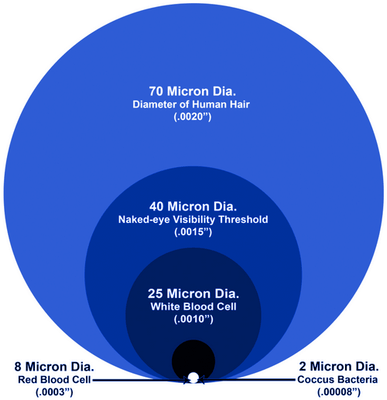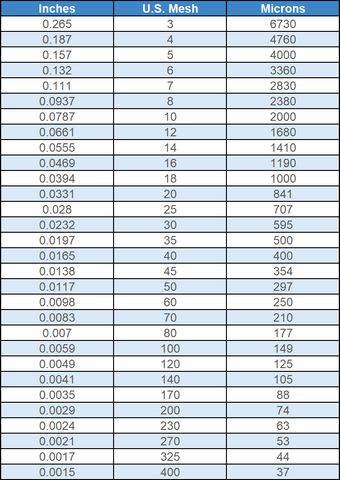When dealing with certain contaminants in water, the size of particulates that your filter removes is critical in determining performance. If you target a contaminant that is no larger than 5 microns, for example, you must ensure that your filter contains a micron rating of at most 5 microns. Accurately converting between mesh size and micron rating allows you to precisely know the size of contaminants being removed from your water. Read on to learn about mesh size, micron rating, and how to convert between the two.
Table of Contents
What is mesh size?What is micron rating?Why are mesh size and micron rating important?What do mesh and micron filters remove?How to convert mesh size to micron ratingMesh to micron conversion chartWhat is mesh size?
Mesh size refers to the number of wires in one inch of screen, not the size of the openings between wires. As the number of wires increases in an inch of screen, the size of the opening decreases. As a result, the larger the mesh size, the smaller the particles that can be removed. A mesh size of 100, for example, contains 100 openings for every one inch of screen. This means the openings are smaller and, as a result, can remove finer contaminants than a screen with a mesh size of lower than 100. Mesh sizes is most commonly referred to in the plumbing industry and runs contrary to micron rating, a number that correlates to the size of particles a filter can remove.
Mesh size most commonly applies to large particle pre-filtration like spin-down filters, bag filters, strainer filters, and other filtration types. These are used to remove large particles before filters that remove smaller particles, such as string filter media, pleated filters, or melt-blown depth filters
Learn more: What is a spin-down filter?
What is micron rating?
Micron rating refers to the size of the pores in filter media. One micron equals one micrometer, or 0.001 millimeter, in diameter. This means a 5-micron filter can remove contaminants that are larger than 5 micrometers. Unlike mesh screens, micron filters can remove more contaminants the smaller their rating. Sediment filters are the most common type of micron filters, but some carbon filters can also function as a micron filter.
Learn more: How many microns should your water filter be?

Why are mesh size and micron rating important?
Mesh size and micron rating are important for targeting specific contaminants in your water. When you learn what contaminants are in your water with a water test, you can target them with a specific water treatment system. In the case of fine and large sediment, dirt and debris, the micron rating or mesh size of a filter tells you which contaminants they will remove. For example, 50-micron filters can remove any particulate that can be seen by the naked eye, while a 1-micron filter can remove most types of bacteria and parasites, such as E.coli, Shigella, and Salmonella.
Learn more: How to test water at home with a water test kit | Lab water tests vs at-home test kits
What do mesh and micron filters remove?
Mesh and micron filters are designed to reduce levels of sediment, dirt, debris, and other contaminants dependent on the micron rating or mesh size of the filter. These filters are often used as pretreatment for other filtration systems, allowing for maximum performance within the treatment system. Homes on well water are particularly vulnerable to sediment, providing the need for sediment pretreatment in the home. Municipal water supplies also contain fine sediment, making sediment filtration important for every home.
Learn more: What is a sediment filter and how does it work?
How to convert mesh size to micron rating
You can approximate the conversions between mesh size and micron rating by diving 14900 by either the mesh size or micron rating. This approximation works best for mesh sizes between 50 and 400. The accuracy of this formula breaks down the further you get from these numbers. For quick conversions, consult our mesh to micron conversion chart below.
Examples:
14,900/100 mesh rating ≈ 149 micron
14,900/250 micron ≈ 59.6 mesh
Mesh to micron conversion chart

If you have any additional questions, please do not hesitate to contact us.
